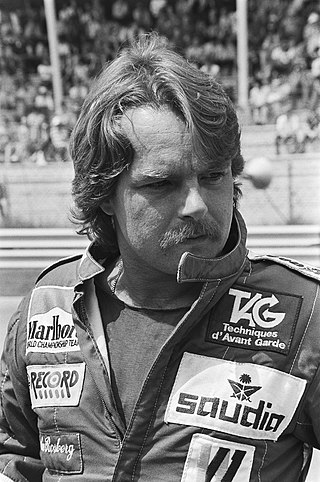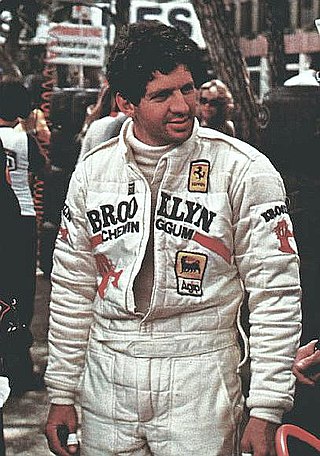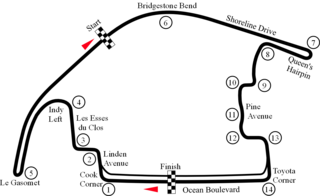
Riccardo Gabriele Patrese is an Italian former racing driver, who competed in Formula One from 1977 to 1993. Patrese was runner-up in the Formula One World Drivers' Championship in 1992 with Williams, and won six Grands Prix across 17 seasons.

Andrea de Cesaris was an Italian racing driver, who competed in Formula One from 1980 to 1994.

The 1975 German Grand Prix was a Formula One motor race held at Nürburgring on 3 August 1975. It was race 11 of 14 in both the 1975 World Championship of Drivers and the 1975 International Cup for Formula One Manufacturers. It was the 37th German Grand Prix and the 34th to be held at the Nürburgring. The race was held over 14 laps of the 22.8-kilometre (14.2 mi) circuit for a race distance of 319 kilometres (198 mi).

The 1977 Canadian Grand Prix was a Formula One motor race held on October 9, 1977, at Mosport Park. It was the 16th and penultimate race of the 1977 Formula One season.

The 1978 Argentine Grand Prix was a Formula One motor race held on 15 January 1978 at Buenos Aires. It was the first race of the 1978 World Championship of F1 Drivers and the 1978 International Cup for F1 Constructors. The 52-lap race was won from pole position by American driver Mario Andretti, driving a Lotus-Ford, with Austrian Niki Lauda second in a Brabham-Alfa Romeo and Frenchman Patrick Depailler third in a Tyrrell-Ford. This was the debut of multiple-time Constructors' Champions, Williams.

The 1978 Monaco Grand Prix was a Formula One motor race held on 7 May 1978 at Monaco. It was the fifth race of the 1978 World Championship of F1 Drivers and the 1978 International Cup for F1 Constructors.

The 1978 British Grand Prix was a Formula One motor race held at Brands Hatch on 16 July 1978. It was the tenth race of the 1978 World Championship of F1 Drivers and the 1978 International Cup for F1 Constructors.

The 1978 Italian Grand Prix was the 14th motor race of the 1978 Formula One season. It was held on 10 September 1978 at Monza. It was marred by the death of Ronnie Peterson following an accident at the start of the race. The race was won by Niki Lauda, after both Mario Andretti (Lotus-Ford) and Gilles Villeneuve (Ferrari), who had finished first and second, were given a one-minute penalty and dropped to sixth and seventh. Lauda's teammate John Watson and Carlos Reutemann (Ferrari) completed the podium.
The 1978 Canadian Grand Prix was a Formula One motor race held on 8 October 1978 at Montreal. This was the 16th and final race of the 1978 World Championship of F1 Drivers and the International Cup for F1 Constructors. It was Ferrari driver Gilles Villeneuve's and a Canadian driver's first victory in Formula One.

The 1980 British Grand Prix was a Formula One motor race held at Brands Hatch on 13 July 1980. It was the eighth round of the 1980 Formula One season. The race was held over 76 laps of the 4.207-km (2.614-mile) circuit for a total race distance of 319.73 km.

The 1982 FIA Formula One World Championship was the 36th season of FIA Formula One motor racing. It included two competitions run over the course of the year, the 33rd Formula One World Championship for Drivers and the 25th Formula One World Championship for Constructors. The season featured sixteen rounds between 23 January and 25 September. The Drivers' Championship was won by Keke Rosberg and the Constructors' Championship by Scuderia Ferrari.

The 1980 Formula One season was the 34th season of FIA Formula One motor racing. It featured the 1980 World Championship of Drivers and the 1980 International Cup for F1 Constructors, which were contested concurrently from 13 January to 5 October over a fourteen-race series. The season also included one non-championship race, the Spanish Grand Prix.

The 1979 Formula One season was the 33rd season of FIA Formula One motor racing. It featured the 1979 World Championship of F1 Drivers and the 1979 International Cup for F1 Constructors which were contested concurrently over a fifteen-round series which commenced on 21 January 1979, and ended on 7 October 1979. The season also included three non-championship Formula One races.

The 1978 Formula One season was the 32nd season of FIA Formula One motor racing. It featured the 1978 World Championship of F1 Drivers and the International Cup for F1 Constructors, contested concurrently over a sixteen race series which commenced on 15 January and ended on 8 October. The season also included the non-championship BRDC International Trophy.

The 1976 Formula One season was the 30th season of FIA Formula One motor racing. It featured the 1976 World Championship of Drivers and the 1976 International Cup for Formula 1 Manufacturers. The two titles were contested over a sixteen race series which commenced on 25 January and ended on 24 October. Two non-championship races were also held during the 1976 season. In an extraordinarily political and dramatic season, the Drivers' Championship went to McLaren driver James Hunt by one point from Ferrari's defending champion Niki Lauda, although Ferrari took the Manufacturers' trophy.

Didier Joseph Louis Pironi was a French racing driver and offshore powerboat racer, who competed in Formula One from 1978 to 1982. Pironi was runner-up in the Formula One World Drivers' Championship in 1982 with Ferrari, and won three Grands Prix across five seasons. In endurance racing, Pironi won the 24 Hours of Le Mans in 1978 with Renault.

The 1980 United States Grand Prix West was a Formula One motor race held on March 30, 1980, at Long Beach, California. It was the fourth round of the 1980 Formula One season. The race was the fifth United States Grand Prix West and the sixth street race to be held at Long Beach. The race was held over 80 laps of the 3.251-kilometre circuit for a total race distance of 260 kilometres.

The Brabham BT46 is a Formula One racing car designed by Gordon Murray for the Brabham team, owned by Bernie Ecclestone, for the 1978 Formula One season. The car featured several radical design elements, one of which was the use of flat panel heat exchangers on the bodywork of the car to replace conventional water and oil radiators. It was removed before the car's race debut, never to be seen again. The cars, powered by a flat-12 Alfa Romeo engine, raced competitively with modified nose-mounted radiators for most of the year, driven by Niki Lauda and John Watson, winning one race in this form and scoring sufficient points for the team to finish third in the constructors' championship.

The Ferrari 126C is the car with which Ferrari raced from the 1981 through the 1984 Formula One season. The team's first attempt at a turbocharged Formula 1 car, it was designed by Mauro Forghieri and Harvey Postlethwaite. The engine chief engineer was Nicola Materazzi.

There have been 74 Formula One drivers from France, the most successful of them being Alain Prost, who won the World Drivers' Championship four times.


















